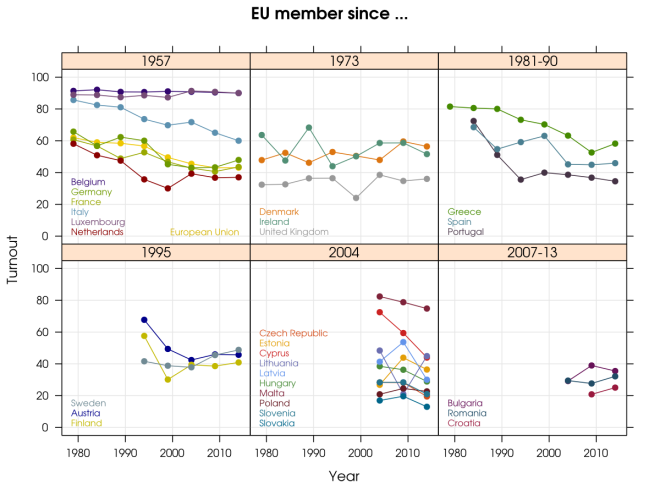These are thrilling times for news agencies. Many hot topics are dominating the headlines right now, seeking for attention: The turmoil in Iraq, ongoing civil war in Syria, the Ukraine crisis and, of course, the football world championship. Among all these troubling and exciting developments, a very important event is threatened to get lost in the public opinion. Roughly one month ago, the European Parliament was elected by the citizens of the 28 EU member states. Now that the dust has settled the election results will lead to restructuring of the political landscape. For many people (and for me as well), European policy has always been boring, ‘far away’ and of inferior importance.
However, this election is different. Thanks to the Treaty of Lisbon from 2009, some important changes are taking place. Despite the gut feeling of many people that the EU is gaining more and more power, the citizens now have more power themselves to stir EU policy. One important novelty is that the European Parliament is now indirectly able to determine the President of the EU commission, which is the powerful executive branch of the EU and usually proposes new laws. The ongoing debate between the two opponents Martin Schulz (social democrats) and Jean-Claude Juncker (conservatives) on who will be the next commissioner reflects this new situation. However, the candidate is actually proposed by the European Council (the 28 heads of the member states), which is only obliged to take the EU parliament’s preferences into consideration. These are the results of this year’s EU Parliament election compared to 2009.

Europe is shifting in the right-wing direction
Don’t be confused by the strange names of the parties as the national parties have teamed up to build European parties or blocks. Color-coded is the dominant party (or the two of them) for each country, and we can clearly see the increase in dark blue in 2014, which represents the conservative European People’s Party (EPP) with their candidate Juncker, housing parties from Christian Democrats to extreme rights like Jobbik (Hungary). Taken for itself, this is not a disturbing result, but it reflects the expression of doubts and concerns among EU citizens, raised over the past five years due to the financial crisis and the ongoing socio-economic problems of the EU (inequality of member states, youth unemployment). The EU can be easily blamed for those failures and the alleged solution is the prioritization of national interests before European ones, resulting in the swing to the ‘right’ direction.
Is nationalism a threat for Europe?
The classic features of right movements and parties are nationalism, independence from multilateral organisations such as the EU, and exclusion of minorities, be they ethnic, social or religious. Is that a threat for European societies?
I think yes, because it disregards the complexity of todays world. First, nationalism is the belief that ones own nation is generally superior to others, which history proved to be wrong, as a nation that is strong at one point can easily fall apart at another. Nationalism also disregards that the world’s countries are more than ever connected by the global flow of goods, resources, workers and even environmental problems. Many of those issues can only be adressed on global or at least continental scale.
Turnout constantly declines
However, a shift in the right-wing direction is a reason for concern but not for resignation. But there are other signs as well that the EU as an administrative institution lacks sex-appeal.
 This figure describes the turnout for 2014’s election for each member state ordered by year of entering the EU. Some interesting trends can be spotted:
This figure describes the turnout for 2014’s election for each member state ordered by year of entering the EU. Some interesting trends can be spotted:
- Belgium and Luxembourg have constantly high turnouts. For their citizens, voting is compulsary.
- Turnout for the new Eastern European members (2004-2013) is very low; obviously they don’t expect much from EU membership or need time to get familiar with this new type of election.
- Turnout for all countries is declining alarmingly, around 20 % for all members taken together.
Absence from elections can be interpreted in two ways, either people are very content and therefore don’t consider it necessary to vote (‘Why should I vote, if everything is fine’) or they don’t trust in politics anymore (‘Why should I vote, if everything stays as bad as before’). I hope for the first.
Sources: European parliament, Le Monde diplomatique’s Atlas of globalisation
# Map was plotted as described in other posts
# The turnout was plotted with lattice xyplot.
# The interesting thing was to add the legend individually per panel
# performed by the explicit declaration of groups and subscripts
# which can be used for panel.key()
Turnout <- read.csv("Turnout.csv")
Turnout_rs <- melt(Turnout, id.vars=c("Country", "EU.member"))
xyplot(value ~ Year | EU.member, Turnout_rs, groups=Country,
col=colorRampPalette(colors[1:8])(29),
main="EU member since ...", scales=list(alternating=FALSE),
type=c("g","b"), ylim=c(-5,105), as.table=TRUE, pch=19,
panel=function(x, y, groups, subscripts, col, ...) {
panel.xyplot(x, y, groups=groups, subscripts=subscripts, col=col, ...)
hits <- (match(unique(groups[subscripts]), levels(groups[subscripts])))
panel.key(as.character(unique(groups[subscripts])), corner=c(0, 0.05),
points=FALSE, cex=0.65, col=col[hits])
}
)